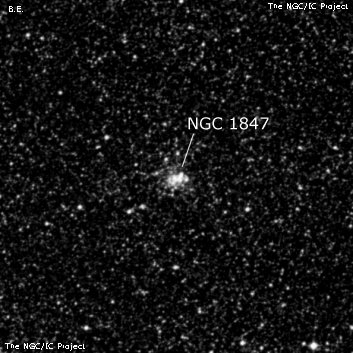
John Herschel discovered NGC 1847 = h2775 on 15 Dec 1835 and logged as "B, E, 30", has a double star in the centre." On a second sweep he called it "B, S, R, gbM, 15"." His position is accurate.
Joseph Turner described and sketched NGC 1847 on 18 Dec 1875 with the 48" Great Melbourne Telescope (plate III, figure 27): "It has a mottled appearance, the bright parts being very bright, as if consisting of very small stars. Sometimes these bright parts sparkle, but I cannot make out any distinct stars, although I feel convinced that these exist. The small star immediately south of nebula and close to it is involved in very faint nebula. H.'s drawing of this object is very unlike its present appearance. He describes it as having a double star in centre and his drawing also shows it so. The nebula presents altogether a more mottled appearance than indicated by H.'s sketch, and the two brighter parts might easily, upon an unfavourable night, be mistaken for the double star with H. shows in his drawing; I can however make nothing more of it than already stated. Night exquisite"
On 19th November 1884, Barachi noted using the GMT: "Pretty large, elongated, bright patches within it, not stars. Sparkling looks as if resolvable, but not so. Agrees exactly with Turner's drawing. Position of neighbouring stars agrees exactly with T. Nebula is most likely unchanged. H. puts a double star in it. This double star is perhaps represented now by the bright patches. It may be that H.'s stars have changed into diffused patches." Both T. and B. consider the lithograph as fairly representing the object."
600/800mm - 24" (11/18/12 - Magellan Observatory, Australia): very bright LMC blue globular, moderately large, irregular elongated shape, high surface brightness glow with a small fainter halo, ~0.6'x0.4'. At 200x, several mag 14.5-15.5 stars are resolved (a couple are fairly easy) within and at the edges of the central glow. NGC 1825 lies 15' WNW, NGC 1856 is 16' SE and NGC 1855/1858 are ~15' NE. John Herschel described a "double star in the centre" and I'm sure this refers to the two brightest central stars.
Notes by Steve Gottlieb